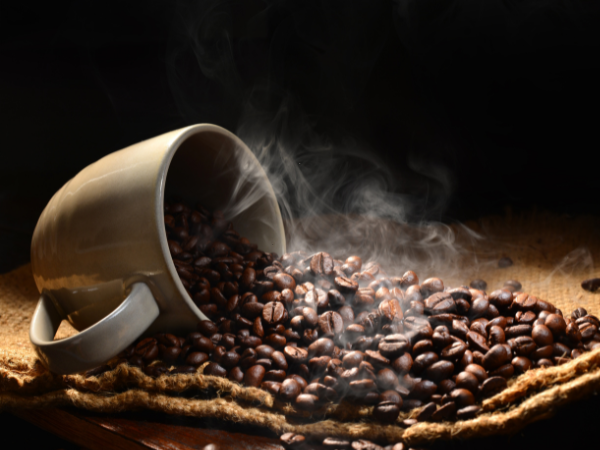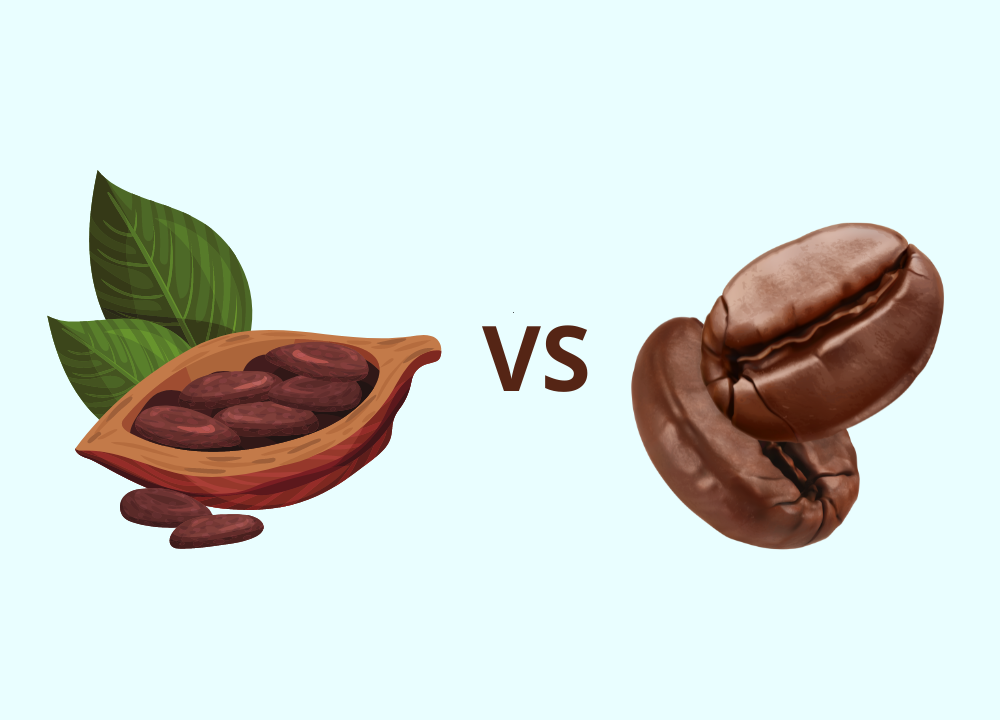Cocoa beans come from the Theobroma cacao tree, while coffee beans come from the Coffea plant. Cocoa beans are used to make chocolate, and coffee beans are used to make coffee.
Cocoa beans and coffee beans are often confused due to their similar appearance and usage in beverages. Despite these similarities, they come from entirely different plants and offer distinct flavors and benefits. Cocoa beans are the source of chocolate and are rich in antioxidants, while coffee beans are known for their stimulating caffeine content.
Difference 1: Origin And Growing Conditions
When comparing cocoa beans and coffee beans, many people don’t realize the fascinating differences between them. One area where these differences are most pronounced is in their origins and growing conditions. These unique factors significantly influence their characteristics and flavors.
Origin Of Cocoa Beans
Cocoa beans originate from the tropical regions of Central and South America. The primary source is the fruit of the Theobroma cacao tree. This tree thrives in hot, rainy climates with temperatures between 20°C and 30°C. Cocoa trees require rich, well-drained soil, and consistent rainfall throughout the year.
Origin Of Coffee Beans
Coffee beans come from the Coffea plant, which is native to tropical Africa, especially Ethiopia. These plants grow best in regions with a distinct dry season and a rainy season. Coffee plants prefer cooler climates than cocoa trees, typically thriving in temperatures between 15°C and 24°C.
Growing Conditions For Cocoa Beans
| Factor | Cocoa Beans |
|---|---|
| Climate | Hot and humid |
| Temperature | 20°C – 30°C |
| Soil | Rich, well-drained |
| Rainfall | Consistent, year-round |
Growing Conditions For Coffee Beans
| Factor | Coffee Beans |
|---|---|
| Climate | Moderate, with dry and rainy seasons |
| Temperature | 15°C – 24°C |
| Soil | Well-drained, fertile |
| Rainfall | Seasonal, moderate |
You might be interested in: Breve vs Latte – 3 Largest Differences
Geographical Spread
Cocoa trees are primarily found in tropical regions near the equator. Major producers include Ivory Coast, Ghana, and Indonesia. Coffee plants grow in over 70 countries worldwide. The top producers are Brazil, Vietnam, and Colombia.
Difference 2: Flavor Profiles And Taste
Cocoa beans and coffee beans offer distinct flavor profiles. These differences can surprise many. Their unique tastes come from their unique chemical compositions and processing methods.
Flavor Profile Of Cocoa Beans
Cocoa beans produce rich chocolate flavors. They have a deep, earthy taste with notes of fruits, nuts, and sometimes even floral undertones. The roasting process enhances these flavors.
| Characteristic | Cocoa Beans |
|---|---|
| Primary Flavor | Chocolate |
| Notes | Fruits, Nuts, Floral |
| Texture | Rich and Smooth |
Flavor Profile Of Coffee Beans
Coffee beans offer bitter and acidic flavors. They can have hints of caramel, nuts, fruits, and even spices. The type of roast and brewing method influences their taste significantly.
| Characteristic | Coffee Beans |
|---|---|
| Primary Flavor | Bitter |
| Notes | Caramel, Nuts, Fruits, Spices |
| Texture | Bold and Smooth |
Factors Influencing Taste
Both cocoa and coffee beans derive their flavors from terroir, fermentation, and roasting. These factors make each batch unique.
- Terroir: The soil, climate, and altitude where beans grow.
- Fermentation: The process that beans undergo post-harvest.
- Roasting: The heat treatment that develops flavor.
These flavor profiles make cocoa and coffee beans unique. Their distinct tastes cater to different preferences, making them both beloved worldwide.

Difference 3: Caffeine Content Comparison
One key difference is their caffeine content. Let’s dive into the caffeine comparison between cocoa beans and coffee beans.
Caffeine Levels In Cocoa Beans
Cocoa beans contain caffeine but in smaller amounts. On average, 1 ounce of dark chocolate has about 12 milligrams of caffeine. This makes cocoa a milder stimulant compared to coffee.
Caffeine Levels In Coffee Beans
Coffee beans are known for their high caffeine content. A single 8-ounce cup of coffee has roughly 95 milligrams of caffeine. This significant amount makes coffee a strong energy booster.
Comparative Caffeine Content
| Product | Serving Size | Caffeine Content |
|---|---|---|
| Dark Chocolate | 1 ounce | 12 mg |
| Black Coffee | 8 ounces | 95 mg |
Impact On Energy Levels
Coffee provides a quick energy boost due to its high caffeine content. It can keep you awake and alert. Cocoa, with its lower caffeine, offers a gentler lift in energy. It’s perfect for those who prefer mild stimulation.
Effects On Sleep Patterns
High caffeine from coffee can disrupt sleep if consumed late in the day. Cocoa, with less caffeine, is less likely to affect sleep. It’s a better choice for a late-night treat.
Difference 4: Nutritional Value And Health Benefits
One notable distinction lies in their nutritional value and health benefits. This section explores the fourth key difference between these beloved beans.
Vitamins And Minerals
Cocoa beans boast a rich array of vitamins and minerals. They contain high levels of magnesium, iron, and potassium. These nutrients support heart health and muscle function. In contrast, coffee beans provide riboflavin (Vitamin B2) and niacin (Vitamin B3). These help with energy production and metabolic processes.
Antioxidants
Cocoa beans are packed with flavonoids, a type of antioxidant. Flavonoids reduce inflammation and improve blood flow. Dark chocolate, made from cocoa beans, is a powerful antioxidant source. Coffee beans contain chlorogenic acid, another antioxidant. Chlorogenic acid helps lower blood pressure and improves mood.
Caloric Content
Calories differ between the two beans. Cocoa beans are more calorie-dense. A 100-gram serving of cocoa beans contains about 228 calories. Conversely, a 100-gram serving of coffee beans has around 2 calories. This makes coffee beans a lower-calorie choice for drinks.
Health Benefits
Cocoa beans offer various health benefits. They improve heart health, reduce stress, and boost cognitive function. On the other hand, coffee beans enhance alertness and support brain health. They also reduce the risk of certain diseases like Parkinson’s.
Fat Content
Cocoa beans contain higher fat levels compared to coffee beans. A 100-gram serving of cocoa beans has about 14 grams of fat. Most of this fat is healthy, unsaturated fat. Coffee beans have negligible fat content, making them a leaner option.
| Aspect | Cocoa Beans | Coffee Beans |
|---|---|---|
| Vitamins & Minerals | Magnesium, Iron, Potassium | Riboflavin (B2), Niacin (B3) |
| Antioxidants | Flavonoids | Chlorogenic Acid |
| Caloric Content | 228 calories | 2 calories |
| Health Benefits | Improves heart health, reduces stress | Enhances alertness, supports brain health |
| Fat Content | 14 grams of fat | Negligible fat |
Difference 5: Uses In Food And Beverages
Cocoa beans and coffee beans are staples in many households, yet they serve different purposes. While both originate from seeds, their uses in food and beverages vary greatly. Understanding these differences can help you appreciate the unique qualities of each bean.
Uses Of Cocoa Beans
Cocoa beans are primarily used to make chocolate. The beans undergo fermentation, drying, roasting, and grinding to produce cocoa powder and cocoa butter. These two ingredients are the foundation of chocolate products.
- Chocolate Bars: These sweet treats are made by combining cocoa powder, cocoa butter, sugar, and milk.
- Hot Cocoa: Cocoa powder mixed with hot milk or water creates a comforting drink.
- Baked Goods: Cakes, cookies, and brownies often include cocoa powder for a rich, chocolatey flavor.
Uses Of Coffee Beans
Coffee beans are primarily used to brew coffee. The beans are roasted and ground before being brewed to extract their flavors. The result is a stimulating beverage enjoyed by millions worldwide.
- Espresso: This strong coffee form is made by forcing hot water through finely-ground coffee beans.
- Cold Brew: Coffee grounds steeped in cold water for an extended period produce a smooth, less acidic drink.
- Baking: Ground coffee can be added to cakes, cookies, and desserts for an extra flavor boost.
Table Of Uses: Cocoa Beans Vs. Coffee Beans
| Product | Cocoa Beans | Coffee Beans |
|---|---|---|
| Primary Beverage | Hot Cocoa | Coffee |
| Popular Sweet | Chocolate Bars | Espresso-based Desserts |
| Baked Goods | Brownies | Coffee-flavored Cakes |
Both cocoa and coffee beans are versatile, offering a range of delightful uses in food and beverages. By exploring these differences, you can better appreciate the unique qualities each brings to the table.

